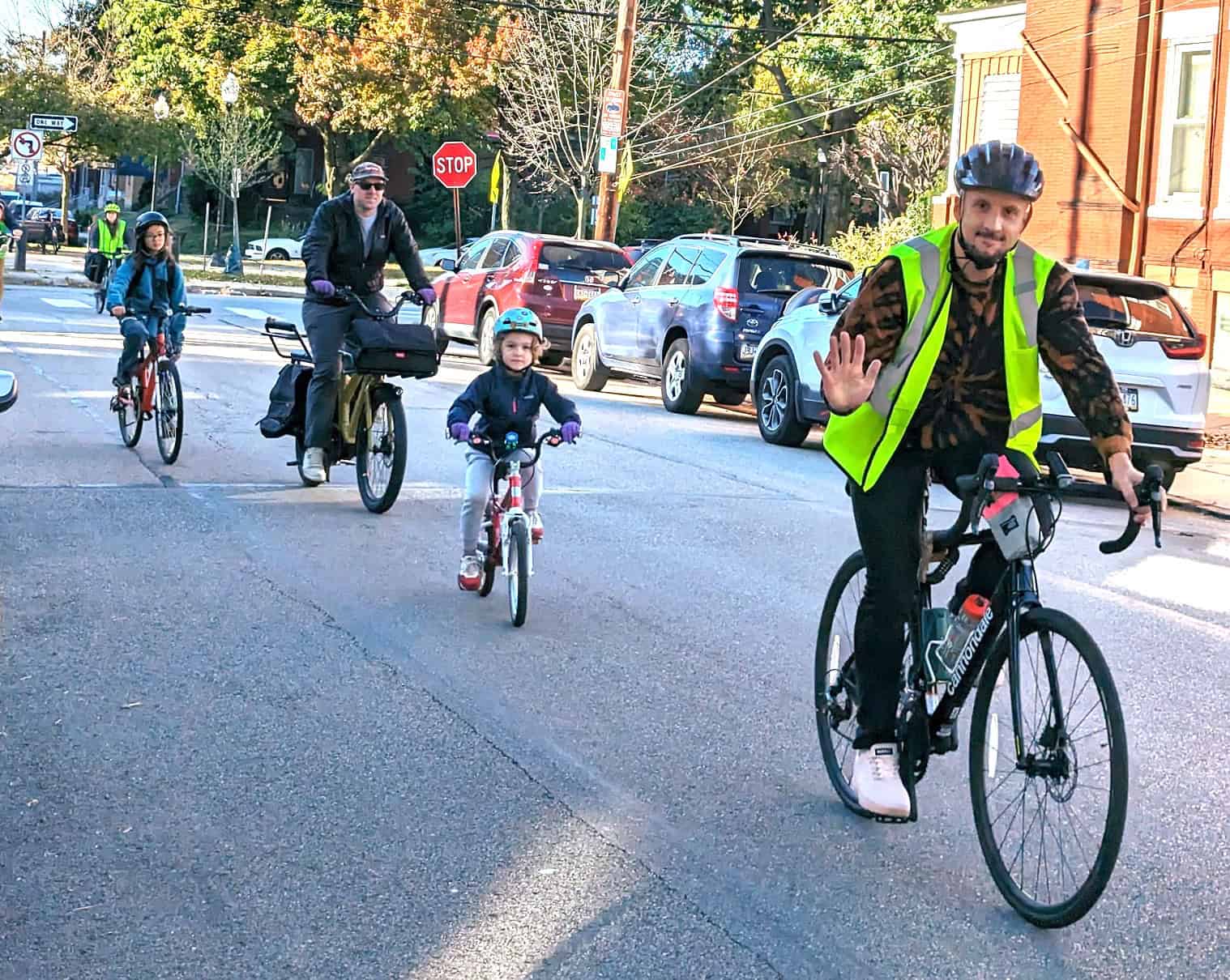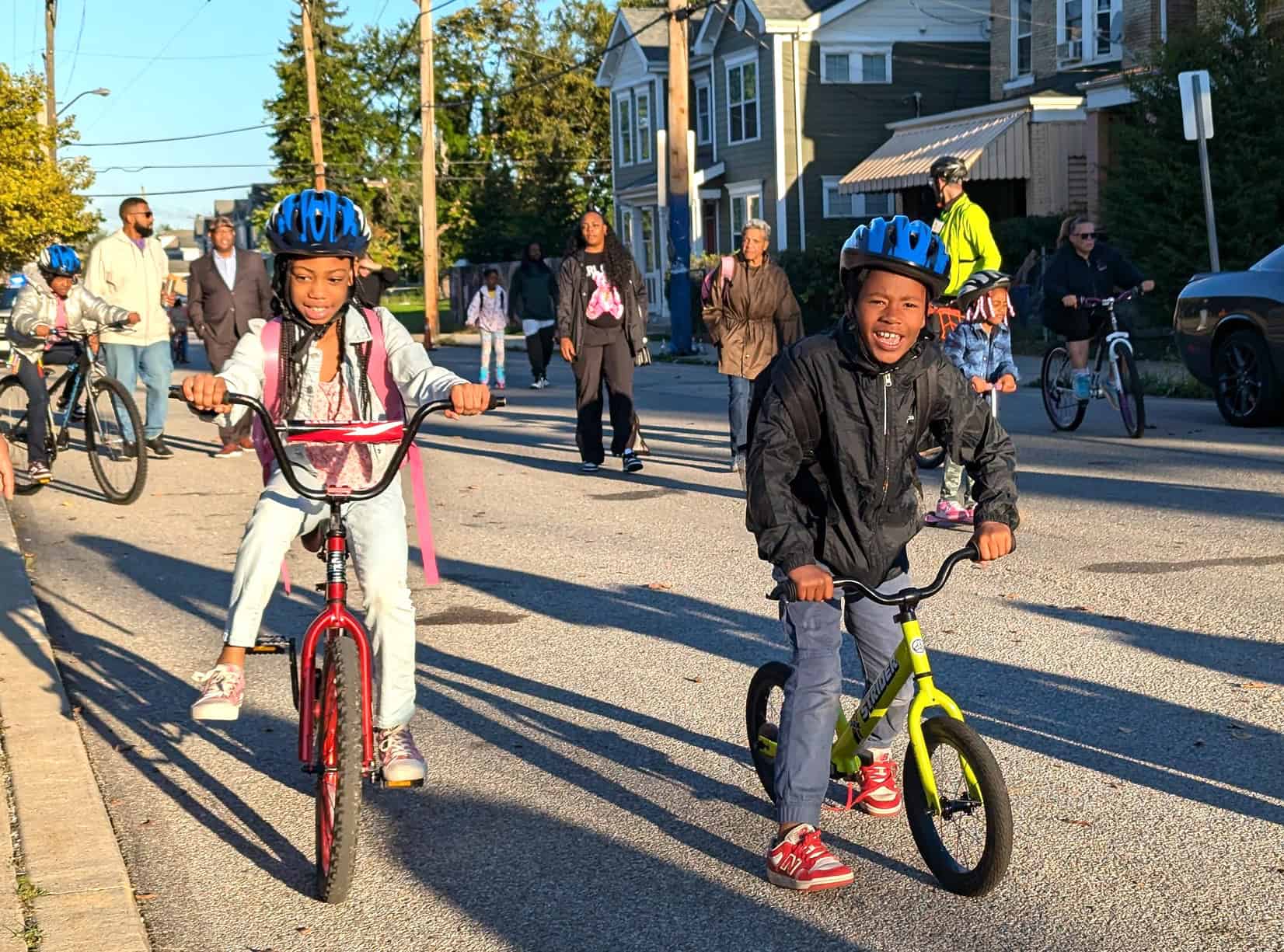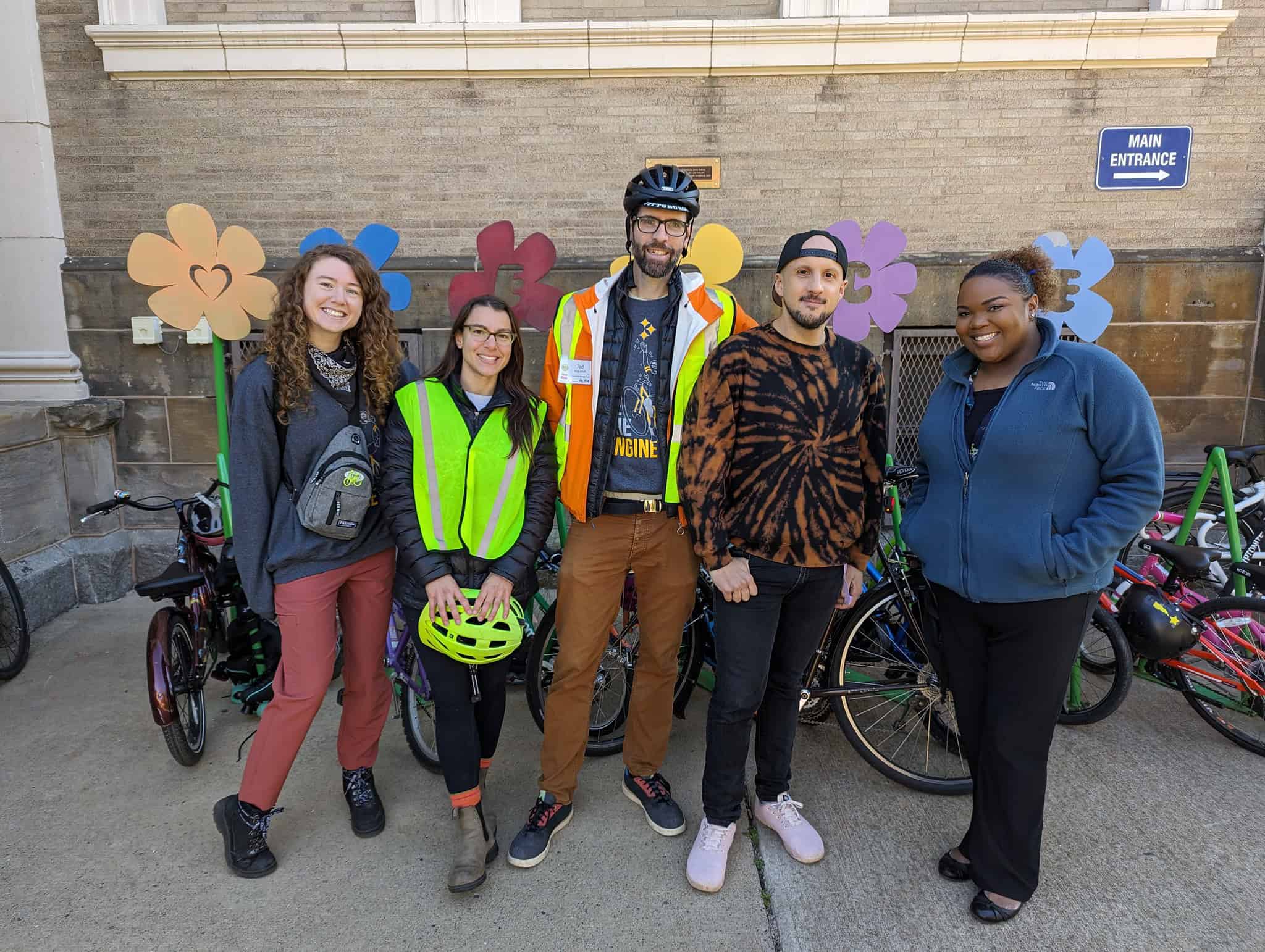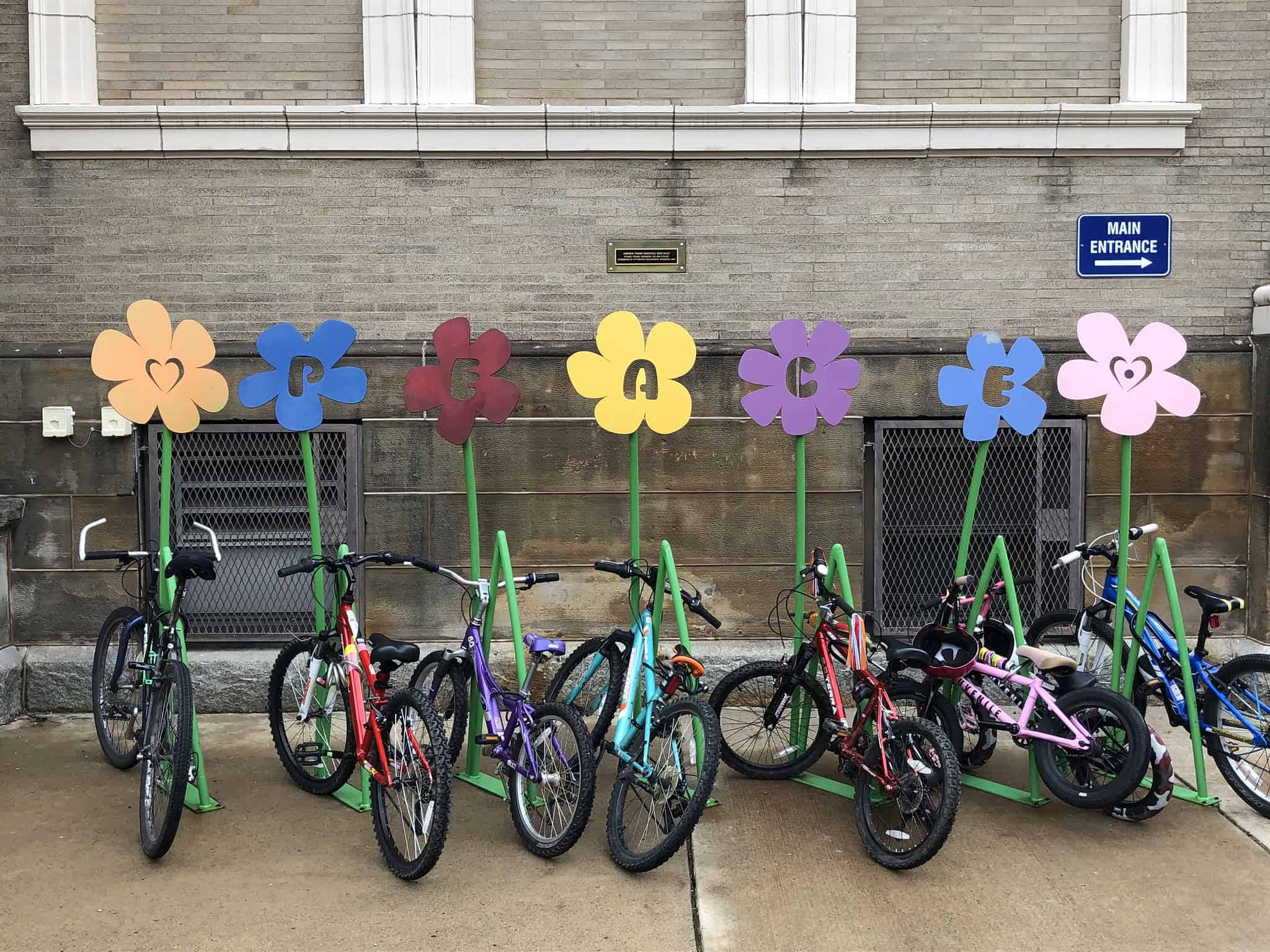How to Start a Bike Bus

Learn all about getting parents and students in your community riding and walking to school together!
“School Buses Run on Gas, Bike Buses Run on Joy.”
Coach Sam Balto – Bike Bus World
Bike Buses reimagine how we get kids to school, replacing pollution and congestion with fun and healthy activity. You, yes you, can make them happen by organizing parents and students in your community to ride or walk to school together. Kids will arrive at school safe and ready to learn because the Bike Bus makes getting to school a fun celebration. Read on for our tips on how to start one up at your local school. Our sincere thanks to Bike Bus World for their inspiration and resources, and PeopleForBikes for their support in getting bike busses on the road in Pittsburgh!
1. Find your “Why”
This differs from school community to school community, for example, maybe your “why” is to:
- Build community and have fun getting to school
- Replace the school bus which was cut
- Reduce drop-off line congestion and pollution
- Encourage more physical activity in the school day
- Give students more options to get to school

2. Find other leaders and volunteers
- Build your team: Find other parents or school staff members who might be interested in biking or walking to school. If kids at your school are biking, try to connect with their parents.
- Decide how to communicate with parents and volunteers

3. Find your route
- Identify where students biking and walking are coming from
- Look for a public park or intersection that could serve as a meeting place
- Identify streets that feature bike infrastructure or traffic calming
- Use the The Pittsburgh Bike Map for help!
- Route length should be between .5 and 3 miles
- Use platforms such as Google My Maps, RideWithGPS, or plotaroute.com to map out your route. You can also create images of your map and cue sheets to share with your team
- Before finalizing, test ride your route during school arrival and departure times
- Timing: Determine what time school starts, then:
- Estimate the time it takes to bike the route at 5 – 8 mph. Then, add a 10 minute buffer before the ride and a 10 minute buffer after the ride. For example:
- A 1-mile long Bike Bus route at 5 mph = 12 minutes.
- 12 minutes plus 10 mins before the ride and 10 mins after the ride = 32 mins.
- School starts at 8:00AM. 8:00AM minus 32 minutes = Start the ride at 7:28AM.
- Estimate the time it takes to bike the route at 5 – 8 mph. Then, add a 10 minute buffer before the ride and a 10 minute buffer after the ride. For example:
4. Bone up on best practices
- At minimum, have an adult leader for every 8 children
- Meet with other leaders to train best practices like following the laws of the road and knowing everyone’s roles. One thing to determine with your leaders is when to cork or split at an intersection.
- Roles:
- Leaders: stay at the front of the group, set the pace, and set an example
- Intersectors: help the ride to get through intersections (AKA corking and splitting)
- Caboose (AKA) back line: stay at the back and make sure that no one is dropped and help any riders who are struggling to keep up or having mechanical issues
- Mechanic: identify some leaders who have tools and experience with bike maintenance to safety check bikes pre-ride and provide mid-ride repairs. These folks should be towards the back
- Engaging with school administration
- Determine when and how to reach out to school administration. Are you asking for permission or simply notifying them of your plans?
- Determine whether you will need pre-registration or permission slips
- Liability
- Determine whether to require waivers, permission slips, or preregistration
- Determine whether to involve school administration in this process
- Supplies + Prep
- Make sure everyone has a functioning bike and helmet
- Lights are recommended
- Adult leaders should have safety vests
- Speakers are a bonus, and a great way to make sure the Bike Bus is conspicuous and fun!
- Bike Parking
- Think through bike parking at school:
- Is there a bike rack and do students have locks?
- If not, is there secure inside storage?
- Have a contingency plan if students don’t have locks or there isn’t sufficient parking space
- Think through bike parking at school:

- Promoting the Bike Bus
- Determine the best way to promote the bike bus to other families and students:
- School newsletter
- School or PTA social media
- Paper flyers, stickers, t-shirts, or other swag
- Determine the best way to promote the bike bus to other families and students:
- Setting the Schedule
- Decide how often to have the bike bus run
- For example: Weekly during the warmer months
- A regular schedule is key to having participation!
- Decide how often to have the bike bus run
See the Bike Bus in action with our “How To” Video!
Learn Even More in Our Webinar with Sam Balto!
Apply to get free helmets, lights and other safety gear for your Bike Bus
Thanks to support from People for Bikes, BikePGH is now offering a resource package for up to five school communities. Each Bike Bus Resource Package can include up to:
- 10 bike helmets for kids and/or adults
- 10 rechargeable front and rear bike light sets
- 10 safety vests
- 10 combination bike locks
- PLUS in-person support from educators to train or ride with your bus!
Note: preference will be given first to public schools in the City of Pittsburgh. Recipients of the Bike Bus Resource package will be notified of acceptance on a rolling basis beginning in March of 2025.
Download our How to Start a Bike Bus Guide
This quick one page guide will help walk you through everything you need to consider to start a bike bus in your community.
Contact Us
Are you bike bus curious but don’t know where to start? We can help you make connections within the school and bike community, consult on your route, and help you find resources for success. Contact us at education@bikepgh.org to find out the next step for your bike or walking bus!